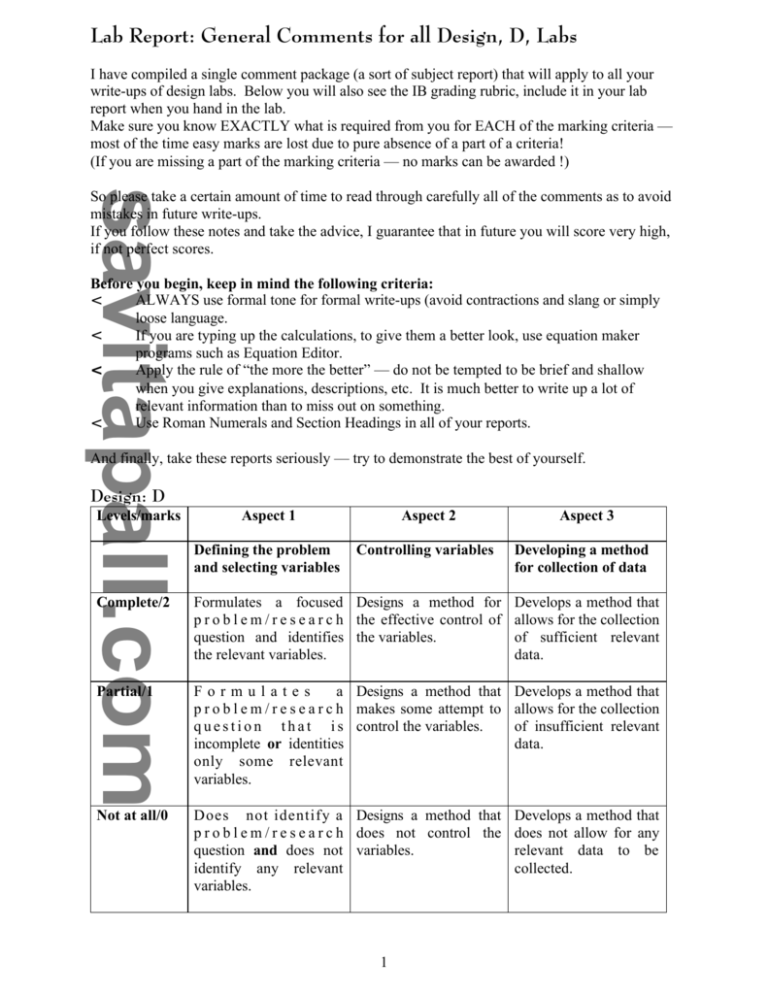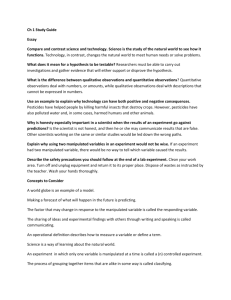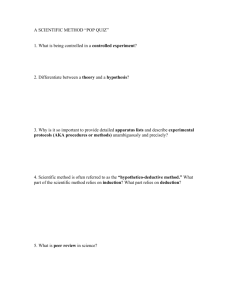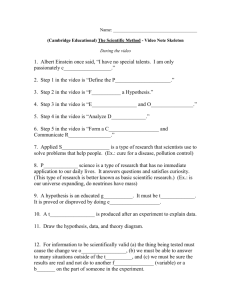IB Design Lab-Explan.. - Savita Pall and Chemistry
advertisement

Lab Report: General Comments for all Design, D, Labs I have compiled a single comment package (a sort of subject report) that will apply to all your write-ups of design labs. Below you will also see the IB grading rubric, include it in your lab report when you hand in the lab. Make sure you know EXACTLY what is required from you for EACH of the marking criteria — most of the time easy marks are lost due to pure absence of a part of a criteria! (If you are missing a part of the marking criteria — no marks can be awarded !) So please take a certain amount of time to read through carefully all of the comments as to avoid mistakes in future write-ups. If you follow these notes and take the advice, I guarantee that in future you will score very high, if not perfect scores. Before you begin, keep in mind the following criteria: ALWAYS use formal tone for formal write-ups (avoid contractions and slang or simply < loose language. < If you are typing up the calculations, to give them a better look, use equation maker programs such as Equation Editor. Apply the rule of “the more the better” — do not be tempted to be brief and shallow < when you give explanations, descriptions, etc. It is much better to write up a lot of relevant information than to miss out on something. Use Roman Numerals and Section Headings in all of your reports. < And finally, take these reports seriously — try to demonstrate the best of yourself. Design: D Levels/marks Aspect 1 Aspect 2 Defining the problem and selecting variables Controlling variables Aspect 3 Developing a method for collection of data Complete/2 Formulates a focused Designs a method for p r o b l e m / r e s e a r c h the effective control of question and identifies the variables. the relevant variables. Develops a method that allows for the collection of sufficient relevant data. Partial/1 Formulates a Designs a method that p r o b l e m / r e s e a r c h makes some attempt to q u e s t i o n t h a t i s control the variables. incomplete or identities only some relevant variables. Develops a method that allows for the collection of insufficient relevant data. Not at all/0 Does not identify a Designs a method that Develops a method that p r o b l e m / r e s e a r c h does not control the does not allow for any question and does not variables. relevant data to be identify any relevant collected. variables. 1 Pre–Lab < < The purpose of the prelab questions is to provide the background information, to demonstrate the relationship to the theory, to explain a new lab technique; and to prepare you for the work to be performed in the lab. The prelab questions will acquaint you with the problem being investigated, and to clarify the pertinent reasons for performing the experiment. Research Question: Defining the Problem < This should be expressed as a question and you must be able to define the aim of the experiment or to identify a focused research question. This is one or more statements describing the investigation. Stated in a list if more than one objective exists: 1. 2. 3. Although the purpose of the experiment is usually provided, however you will be expected to identify the purpose of the experiment before, during and after the lab work has been performed. < < Hypothesis < < < < < < < < The hypothesis is what you think will happen during the investigation. The hypothesis is your prediction and should be formulated to be an answer to the research question and should explain the rational used to state the prediction, i.e. using theory for your hypothesis, (it differs from a guess in that it is based upon prior knowledge or evidence and/or concepts). The hypothesis should relate directly to the research question. It should be specific and quantitative. This should express a possible relationship between two or more variables, e.g. “If ..... (manipulated variable)..... is done, then ..... (responding variable) ...... will occur ...... because ..... (reasoning) ......”. The hypothesis to the research question may also be explained in terms of a scientific concept (for example, a theory, law, or generalization), or another authority (for example, a reference source, or a label on a bottle). Qualitative and quantitative reasoning should be included in the hypothesis. Show the calculations you have used to arrive at your quantitative reasoning. Note that your hypothesis does not need to be correct, i.e. your investigation might prove it incorrect. Variables < < < < < < < State the main variables explicitly and explain why each is relevant to this investigation. State which variables are independent and which are dependent (manipulated and responding). Indicate which variables need to be controlled Manipulated variable: is the factor that you, the experimenter changes in a systematic manner during an experiment. Responding variable: is the result or change that occurs due to the manipulated variable. Controlled variable: those other factors which must be kept constant so that they do not affect the experiment and the manipulated variables. It would be also beneficial to give a brief explanation, where relevant, of why a factor is that specific variable. 2 Apparatus and Materials < < < < These are reported as separate vertical columns, divided clearly into two lists: 1. Materials (i.e. the materials used), 2. Apparatus (i.e. the equipment used). This makes it easy to interpret and provides a professional tone/style to the report. State a complete list of all equipment and chemicals including sizes and quantities. List all major pieces of apparatus in detail (i.e. specific: 100 cm3 beaker instead of simply stating “beaker”, e.g. thermometer, –10 OC to 110 OC range, 0.2 OC graduations). When more complex equipment configurations are required, a diagram of the apparatus set up is included at this point. Also very important: state EXACT quantities used in the experiment, e.g. 2.50 g sodium chloride, 250 cm3 beaker, etc. < Method /Procedure < < < < < < < < < < < < < < < < < < Usually this reads as “refer to resource lab sheet please”. If the students design their own labs (as is the case several times in the year) the procedures are then stated by the student here. Very important — please write procedure in past tense, (i.e. “ a table was prepared” or “a match was lit”, etc.), — it is better that you do NOT instruct the reader, but instead tell/describe what you did when you performed the experiment. Before the experiment is performed, data tables are constructed —> need to have this phrase at the beginning. More obvious/explicit indication of how the procedure allows for control of the variables. Design a method which collects sufficient and relevant data for the variables under investigation and controls the other variables. The procedure is detailed set of numbered, in vertical columns, with one set of instruction per step in the correct sequence (i.e. in the order you would do them in the investigation). Provide sufficient details so that another person could repeat your work. Your procedure should allow collection of sufficient relevant data. Do not be tempted to assume that the reader/corrector/teacher knows the ‘obvious steps’, when it Is necessary to state them, since they constitute a part of the marking criteria and makes the procedure section more complete. Better to make too detailed then to miss out on something or provide insufficient information! If your procedure does not have a CLEAR indication that allows for the collection of QUALITATIVE data, then full marks will not be attained for one of the categories (insufficient collection of data). State CLEARLY in which of your prepared data tables the collected qualitative and the quantitative data must be recorded. The final step may include a statement of any safety precautions and waste disposals specific to the procedure. The design of the experiment may be concept maps or flow charts of simple apparatus diagrams which are numbered to indicate order or sequence. Creativity is encouraged, without loss of clarity to convey information to the reader for purposes of “lab reproducibility”. If a diagram is used to show the arrangement of the apparatus, then it should be a large clearly labelled diagram. State any assumptions that are valid in the method chosen for the experiment. Note that lab design is different from a Lab Report where you would describe the method in paragraph form and in past tense. 3






